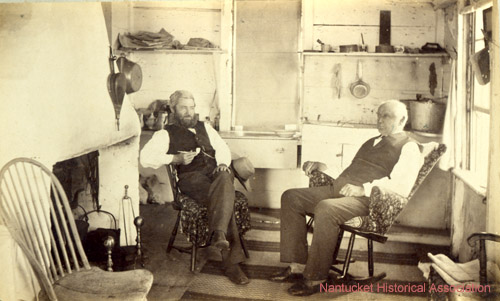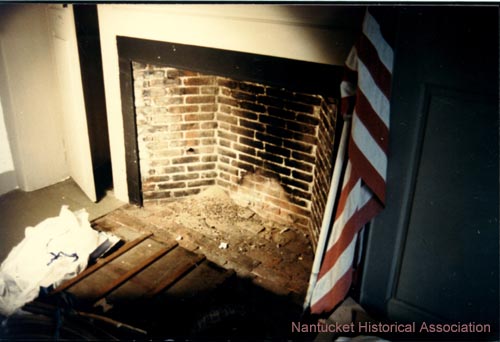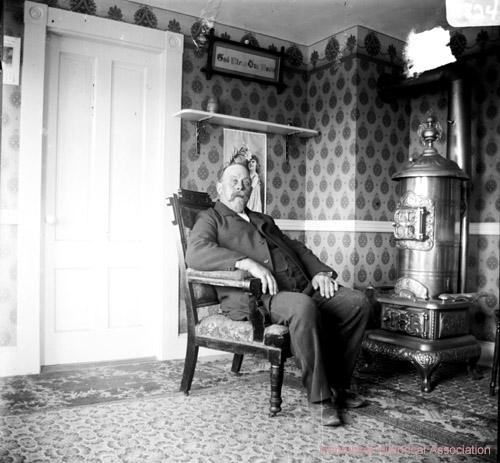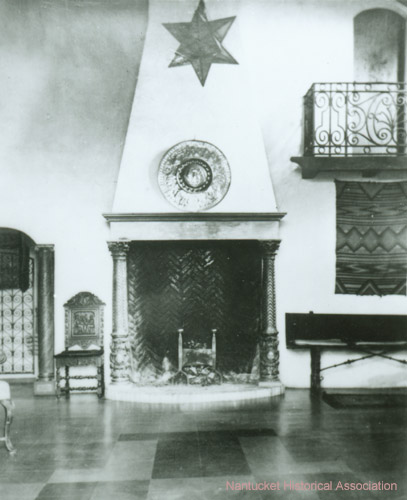The stockings were hung by the chimney with care,
In hopes that Saint Nicholas soon would be there…

The official start of winter is still a week away, but it’s cold here on Nantucket. There’s nothing that transports you back in time more than walking along our historic streets and seeing smoke curling out of chimneys, the smell of woodsmoke filling the crisp air.
In a place where the sun sets at 4:15 in the afternoon, winter means long, cold nights perfect for crackling fires. Today, most of our homes are heated by electricity or gas, and while a roaring fire brings a certain glow to winter nights, we are no longer reliant on fireplaces for heat.
Fireplace chimneys are also central to one of America’s most iconic winter tales: Saint Nicholas (Santa, St. Nick, Father Christmas…) slipping down the chimney to deliver toys to children on Christmas Eve.
We wanted to look a little more into the history of fireplaces and find out just when Santa started shimmying down them.
Colonial fireplaces were quite wide and deep to allow for multiple cooking pots and multiple fires for cooking and baking. These large fireplaces lost a lot of heat, but their huge central chimney masses of stone or brick helped to keep houses warmer overall.

Up until about 1800, homes were primary heated by wood burning fireplaces. In the mid 1700s, Benjamin Franklin invented the Franklin Stove, a metal insert for fireplaces. Through a series of baffles, Franklin’s stove intended to direct the flow of air and help retain heat longer.
In 1795, Benjamin Thompson, also called Count Rumford, invented the Rumford fireplace design. Rumford tested firebox designs until he found one that worked best. The Rumford fireplace is shallow, taller than it is wide, with sharply angled walls on either side to reflect heat.

A Rumford fireplace draws air into the fireplace more efficiently, which allows the flame to burn strongly and clearly. Thomas Jefferson was a fan of the ingenious design, and when he remodeled Monticello in the 1790s, Jefferson had eight Rumford fireplaces installed.
When coal, steam, and gas became the preferred methods of home heating, efficient fireplaces were no longer needed. More modern fireplaces have a larger firebox so that a crackling fire is set further away from people.

Homes heated by wood needed large chimneys to support multiple fireplaces, but houses built in the later part of the 19th century needed only enough space for a stove pipe, which means smaller chimneys.
So how does Santa Claus fit into all this?
In Washington Irving’s 1809 story Knickerbocker’s History of New York, there is a reference to Saint Nicholas flying over the rooftops of houses, pausing to drop “magnificent presents” down the chimneys of his favorite boys and girls.
Another New York writer, Clement C. Moore, helped cement the popular image of Santa clambering down chimneys with gifts in an 1822 poem, “A Visit from Saint Nicholas.”
Down the chimney St. Nicholas came with a bound.
He was dressed all in fur, from his head to his foot,
And his clothes were all tarnished with ashes and soot;
A bundle of Toys he had flung on his back,
And he looked like a pedler just opening his pack.
If the story of Santa coming down the chimney didn’t enter into our popular imagination until the 1820s, what happened if you didn’t live in a house with a massive chimney? As coal stoves grew in popularity, Santa, legend has it, was also known to shimmy down a stove pipe.

As the years progressed, there were even some traditionalists who worried that modern inventions like steam radiators would put an end to the Santa story. Yet in 2018, more than 200 years after Irving’s story first appeared, when most homes are heated by electric or gas heat with no fireplace to be seen, children still hang their stockings and wait.
Whatever you celebrate, and however you heat your house, we hope you stay warm this winter!


